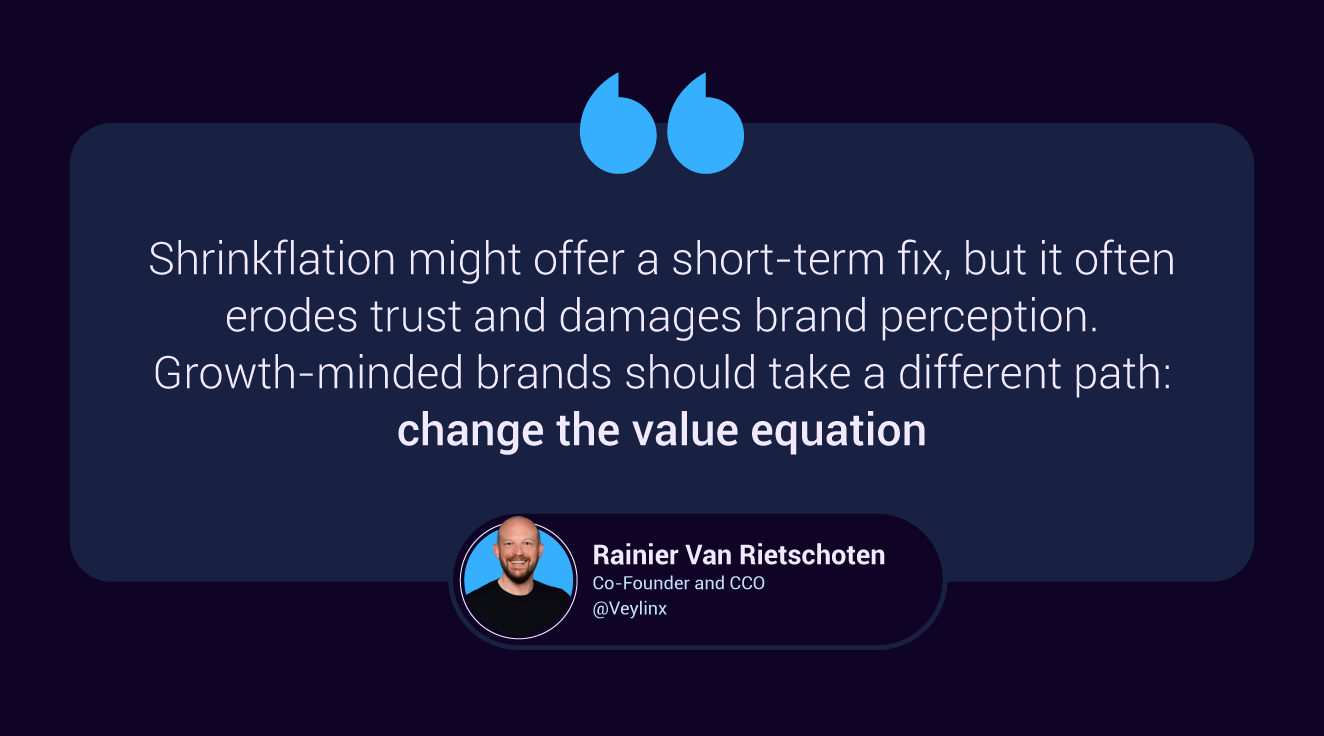.png)
Pricing with purpose: How to get it right in inflationary times
Pricing is one of the most powerful levers in a brand’s toolbox—but it’s also one of the easiest to misjudge. Price too high, and products fail to convert. Price too low, and brands leave value on the table or risk devaluing their proposition. So how can pricing decisions be made with confidence, especially during inflation?
To answer these questions, we asked Veylinx Co-Founder and pricing and transactional insights expert Rainier van Rietschoten to be our guest author, bringing Veylinx’s unique transactional research approach and extensive experience in “the science of pricing” to the table.
This article explores three critical forces that must be aligned to get pricing right: consumer value, brand positioning, and internal costs. It also explains why understanding the category role is essential to interpreting consumer willingness to pay—and why transactional insights, not claimed data, are key to bridging the gap between what consumers say and what they actually do.
Inflation’s impact on pricing: Why transactional insights matter more
As inflation reshapes consumer behavior worldwide, pricing has become an even more sensitive and strategic decision. Shoppers are increasingly value-conscious - comparing prices across channels, trading down to lower-cost alternatives, and reassessing what’s truly worth a premium. But inflation does more than squeeze budgets; it changes the mental thresholds consumers use to judge price fairness. This means pricing decisions cannot rely on historical benchmarks or intuition alone.
.png)
Brands need tools that reveal actual demand at different price points, not just theoretical preferences. Traditional pricing research often relies on surveys where consumers state what they would pay for a product; however, these methods are prone to overstatement and hypothetical bias, as people tend to say one thing but act differently when real money is involved.
To close this intention-action gap, the Veylinx methodology uses behavioral science to simulate real-world purchasing decisions—consumers are presented with actual products at varying price points and must decide whether or not to buy, without knowing the study's true objective. These transactional insights provide a far more accurate picture of price elasticity and real demand, making them especially critical in inflationary times. (Of course, the say-do gap isn’t limited to price testing. That’s exactly why the EyeSee–Veylinx collaboration is such a natural fit, offering clients a fully behavioral methodology portfolio that covers every aspect of product testing.)
Aligning the three pricing lenses
Building on these insights into consumer price sensitivity and perceived value, getting pricing right also requires aligning three distinct but interconnected perspectives:
- Value-Focused Lens (Consumer Focus) : What is the product worth in the eyes of the buyer? How much benefit do they perceive, and what trade-offs are they willing to make?
- Competitive Focused Lens (External Focus): This means evaluating your competitive landscape—understanding where your product sits on the market and whether you want to be positioned as a premium or value offering.
- Cost-Focused Lens (Internal Focus): It’s based on production cost plus your desired margin. This gives brands a baseline for pricing. It is simple but essential: if you’re competitively priced and valued by consumers, but you’re not covering costs—you’re losing money.
When these three lenses are not aligned, brands risk sending mixed messages, underperforming in the market, or losing shelf space. When they work in harmony, pricing becomes a driver of value creation and brand strength.
Category role determines pricing flexibility
Speaking of alignment, another essential factor to consider is the role a product plays in its category—because it directly impacts its price elasticity.
.png)
Typically, categories include:
- A-Brands (Leaders): High price, high volume, strong loyalty.
- Challenger Brands: Competitor-focused, seeking to steal share.
- Value Brands: Cost-focused, thriving when consumers trade down.
- Niche Brands: Premium, lower volume, purpose-driven.
In times of high inflation and decreasing spending power, lower-value products at lower prices naturally become more attractive. To justify the higher price, premium propositions must deliver significantly more perceived value. This also means they will increasingly compete for share of wallet with completely unrelated categories.
Understanding your category and brand role—necessity vs. luxury, leader vs. follower—is foundational to adjusting your pricing strategy.
Burned by shrinkflation? Here is what to do instead
In times of high inflation, consumers scrutinize every purchase—they’re not just looking for lower prices, but better value for money. Shrinkflation might offer a short-term fix, but it often erodes trust and damages brand perception. Growth-minded brands should take a different path: change the value equation.

There are three powerful ways to do this:
- Elevate existing products through smarter packaging, stronger claims, or refreshed design—small changes with a big impact. (EyeSee's variety of pack testing solutions for every stage of the brand renovation process can guide this effectively.)
- Invest in premiumization by adding meaningful features—like a resealable lid that improves freshness and convenience.
- Pursue true innovation by solving unmet needs and launching entirely new value-driven solutions.
When shoppers are laser-focused on getting the most for their money, brands must meet them with more perceived and real value—not less.
In Conclusion: Pricing with purpose during inflation
Let’s wrap up with three actionable takeaways:
- Consumers are more price sensitive than ever. Measure actual behaviors—not just claimed preferences—to understand demand elasticity and price thresholds.
- Align your pricing lenses. Cost, competition, and perceived value must work in harmony to protect both volume and margin.
- Innovate with relevance. The most successful brands aren’t just raising prices—they’re improving experiences in ways that feel worth it to consumers.
Inflation may be a challenge, but with the right tools and insights, it can also be a moment of reinvention and inspiration that leads to future growth.
Eager to learn more about premiumization strategies? Read more here.










